Managing Indicators
Indicators are objective, population-level measures that can be useful in understanding community trends and assessing the impact of collective community action on longer-term outcomes in a community.
Indicators can be graphed on their own to determine changes in the measure over time, or they can be graphed together with Accomplishments to determine if there is a correlation between the level of Accomplishments and changes in the Indicator. Information from the Indicator database can also be exported into Microsoft Excel for further analysis.
Indicator Overview
Each Indicator includes several fields for specific information about the Indicator. These fields include:
- Indicator: The specific Indicator of interest (e.g., percent of Kansas 10th graders reporting "yes" to 30-day use of alcohol in 2010).
- Data Source: The source of the data that you are entering (e.g., Dept. of Health and Human Services, U.S. Census, Behavioral Risk Factor Surveillance System, etc.).
- Initiative: The specific initiative to which the Indicator is related.
- Topic Area: The category that the Indicator relates to (for example, Health Behaviors, Substance Abuse Prevention, Preventive Care, etc.).
- Indicator Description: This provides more detailed information about the Indicator and what it represents.
- Share: Checking this box makes this Indicator data available to all users of the Community Check Box, including users outside of your project. If you do not check this box, users within your project will still be able to view this data.
- Geographic Level: This box allows you to select at what geographic level the Indicator is taking place – City, State, a specific Zip Code, County, or Census Tract. You can also choose to enter a specific address. Your project also has the option to add a custom geographic level, if the Indicator is not taking place in one of the specified options.
These fields will always be included in the Indicator, and individual projects also have the option of adding five additional fields that are customized to the information they would like to collect.
In addition to the standard fields listed above, there are optional fields that you can choose to customize for your project.
Although the Administration page and Create Indicator function are available to all users, we encourage project leads/site Administrators to do the majority of the work for these capabilities, and to train users to check with the project lead before they update the Administration page or create a new Indicator for the first time. This is to ensure that duplicate Indicators are not being created, and that Indicators are created with consistent methods and data. So this first section applies primarily to the administrative functions for Indicators, and then the remainder of the document will cover Indicators functions available for all users.
Access to the administration is available from the Indicator Management screen.
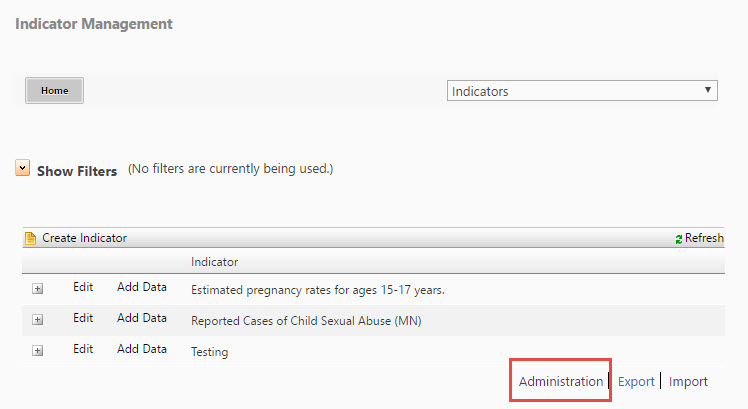

Administration allows for the customization of the form that appears for documenters.
Administrators can designate whether fields appear on the Indicators web part, or on the listing in the Indicators Management page. Additionally, there are five fields that are available for customization, which Administrators can choose to include On WebPart or On Listing. For all fields, you can customize the choices available within the form, or add help text to the fields displayed.
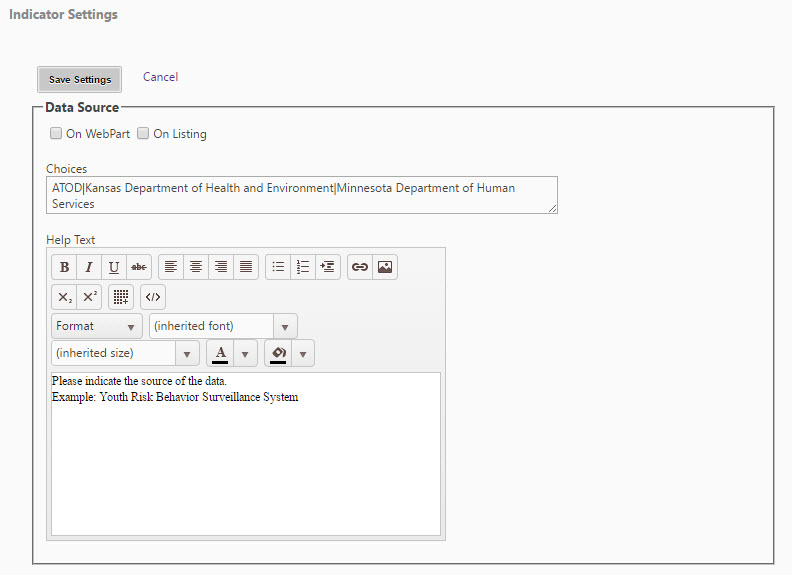

There are a variety of customizable fields available. To customize one of the fields shown on the data entry form, populate the details as appropriate for the particular field.
For example, when customizing the Data Source, select the appropriate checkbox if the field should appear on the web part, on the listing, and the various data sources (choices) that will be available through a drop-down menu and the help text.
When adding choices, be sure to use the "|" between the choices (this character is called a pipe, and it is located above the "Enter" key on your keyboard, together with the forward slash. You can make the pipe separator by holding down "Shift" and hitting this key). Make sure that you do not include any spaces between choices. So an example would be: Choice 1|Choice 2|Choice 3
Help text is automatically populated for all fields, but if you would like to customize it for your project, you can edit that in this screen.

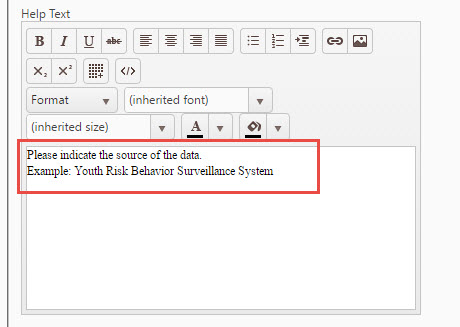

When Help Text is populated, this  icon will appear next to the associated field on the form and users will be able to click on that and view a pop-up box with either the automatically generated Help text, or your customized guidance.
icon will appear next to the associated field on the form and users will be able to click on that and view a pop-up box with either the automatically generated Help text, or your customized guidance.
Optional Custom Fields
Additionally, there are five available Custom Fields that you can choose to add to your Indicator data entry form, depending on specific information that your initiative wants to collect.
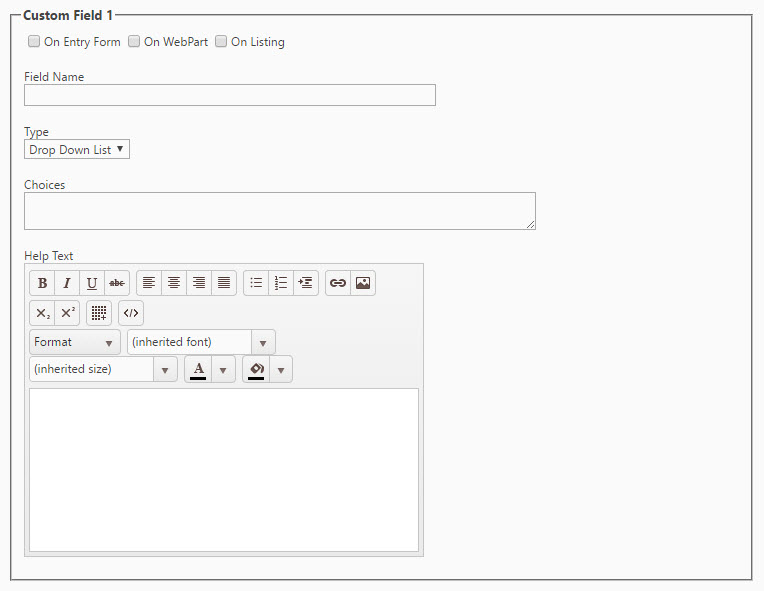

You must check the On Entry Form box for the Custom Field to show on your entry form. You also have the option of whether it should be displayed on the web part or on the listing display in the Indicator Management page. Fill in the Field Name box with the title of the information you want to gather, and then if you want it to be a drop-down menu, enter all Choices. Or, you can choose to have it be a text line that allows users to enter their own answers. You also have the option to populate customized Help text for these fields.
Once you have customized the Administration page with all the fields you will need, and filled in all the choices you want to appear in the drop-down menu for those fields, hit the Save Settings button.
Next, you will want to create entries for all of the Indicators that you anticipate using for your project. When users enter their data for the Indicators, they can select the specific Indicator and add rows with Start Date, Stop Date, Value, and Notes, and not have to enter any of the other information. This will reduce the possibility for duplicate Indicators being created and affecting the accuracy of your data.
This can be done by clicking the Create Indicator button at the top of the Indicator Management page, the link at the bottom of the webpart, or if your site uses buttons, the Create Indicator button on your main CCB page.
This will take you to a blank Indicator page, where you can fill in all of the information about your Indicator and then save it.
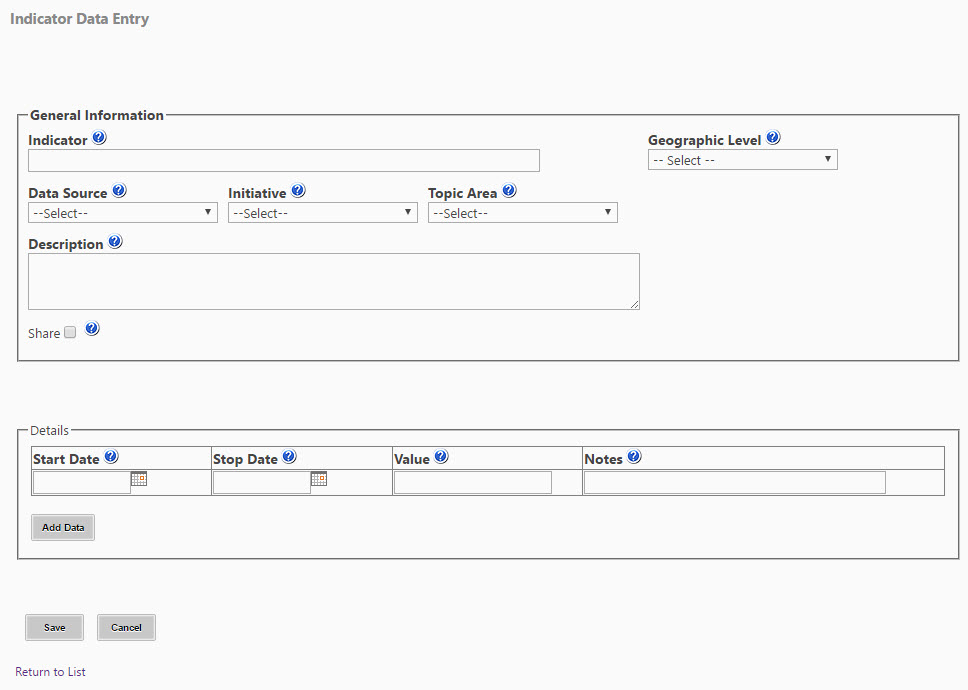

Once you have created all of the Indicators that your project will be measuring, users can then choose Indicators from the webpart, the listing page, or the Add Indicator Data link at the bottom of the webpart, and continue adding new data to the existing Indicator entry.

